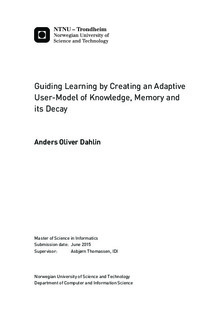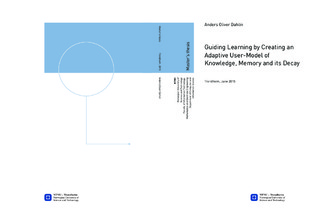| dc.description.abstract | Background
As time pass, education has been an ever growing enterprise. The past 150 years obligatory education has grown from almost non-existent to a project that takes most of our childhood. Adding more years to an already long education is out of the questions, but there are other improvements that can be done to make sure our children learn what they need to know.
Objective
The main objective of this paper is to find out how computer systems can help this improvement process.
By adapting the learning system based on each students needs and prior knowledge, can we guide the learning process so that they only need to work on the topics where they have the necessary dependencies memorized already?
There is also an attempt to find weather we can use existing cognitive architectures(mainly ACT-R) to achieve this.
Research method
First, we discuss different educational paradigms and research done on what the best learning experience is like. Second we go through different theories surround how memory and forgetting works. Finally we go through what a cognitive architecture is and how ACT-R works, to then translate that into a the issue at hand.
Results
It was found that there are big gaps between the theories surrounding how people best to learn new things and how it is done in schools.
When people learn something new it is put inside their working memory and over time rehearsed so it gets consolidated in long-term memory as well. The more items in working memory at the time the more competition there is for rehearsal, that's why you learn better when focusing on one thing at the time.
Even after a memory is consolidated in long term memory it is not necessarily permanent. The brain deletes useless memories all the time. It is not known exactly how this happens, but it is usually based on a function of time. There is also evidence of similar memories conflicting with each other. Forgetting things is not a weakness, it's just how humans work. It is therefore important that in an attempt to help people learn we should not believe memories last forever.
Taking this into account it was found that an adaptive system for helping people learn need to try and predict when users will forget things and then trigger a recall in order to consolidate the memory even further.
It was also found that it must use the model of what the user knows and don't know to make sure the user is allowed to only work on topics they feel comfortable working on. Not too hard, not too easy.
An argument was raised that we should not attempt to force people to remember everything forever as human attention is a commodity and as technology advances we already have different tools available for accessing long term storage of information.
Only the information useful to the individual needs to be remembered after it has been processed.
ACT-R works by using time-stamps of when memories have been accessed and creating an activation value based on those. That activation is then combined with a signal from it's neighbours to create a probability for the mind being able to recall that information again at any specific time.
By creating a tree or graph of different declarative information nodes and their dependencies we can use the activation function from ACT-R to predict users ability to remember different topics and use that prediction to guide their learning. | |

